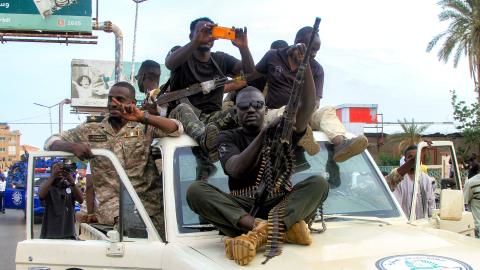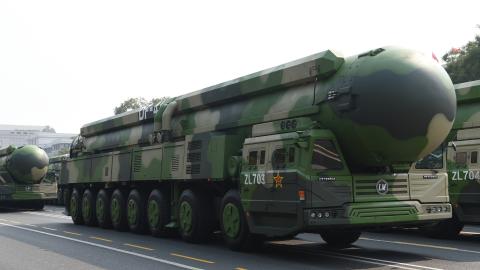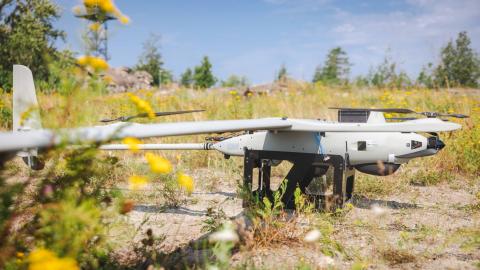An Iranian official recently boasted that Iran’s ballistic missiles can reach American military bases. This is not news. But it does remind U.S. policymakers why the Joint Comprehensive Plan of Action (JCPOA) will increase the threats facing our armed forces, especially since the agreement will provide Iran with greater opportunities to advance its missile program. This is reason enough for the United States to walk away from the deal. But since it looks certain that it will not, it must adapt its ballistic missile defense strategy to mitigate the increased risk brought about by the deal.
The JCPOA will lift conventional arms and ballistic missile embargoes that the United Nations has long imposed on Iran. Iran’s ballistic missiles pose a significant threat to U.S. allies and military personnel in the Middle East. This is why Chairman of the Joint Chiefs of Staff Army Gen. Martin Dempsey told a Senate panel in July that, “Under no circumstances should we relieve pressure on Iran relative to ballistic missile capabilities and arms trafficking.” Defense Secretary Ashton Carter similarly told a Senate panel, “We want [the Iranians] to continue to be isolated as a military, and limited in terms of the kind of equipment materiel they are able to get.”
The growing threat from Iran’s ballistic missiles is one of the primary reasons the Obama administration said it changed the missile defense architecture for Europe. In 2009, Undersecretary of Defense for Policy Michele Flournoy told a congressional panel, “In the near term, what this means is that the greatest missile threats from Iran will be to U.S. allies and partners, as well as to our deployed personnel, military and civilian, and their families in the Middle East and in Europe.” She added, “I just want to underscore, this is the key change in the intelligence assessment that drove our action: the very real threat of short-range and medium-range ballistic missiles that is developing faster and must be dealt with sooner.”
Although the administration’s strategy for missile defense wrongly prioritized regional missile defense abroad at the expense of defense of the U.S. homeland and investments in cutting-edge technologies, Ms. Flournoy’s assessment that Iran’s current missile arsenal is an immediate and growing threat is absolutely right. And it will continue to grow bigger and more capable. As Iranian President Hassan Rouhani said in the wake of the deal, “We will buy, sell and develop any weapons that we need, and we will not ask for permission or abide by any [U.N.] resolution for that.”
Of particular concern is Iran’s continued development of long-range ballistic missile technology. Iran has demonstrated its commitment to acquiring an intercontinental ballistic missile (ICBM) by launching satellites, including as recently as February. Satellite launch vehicles possess technologies directly applicable to those of ICBMs.
If the United States, either by congressional action or by a change in decision from the executive branch, fails to thwart the Iran deal, it must prepare for the repercussions.
First, the United States must return the Missile Defense Agency to the flexible and innovative agency it was when it was created. Programs that promised the greatest qualitative improvements to our missile defense system were canceled by the administration in 2009, beginning a series of significant spending cuts to the agency. When combined with dramatically increased funding requirements for operations, sustainment and support of existing missile defense systems, the budget authority Missile Defense Agency can apply to developing the next generation missile capabilities is woefully short. Engineers and scientists must be given the resources and support not only to improve current systems but to develop revolutionary technologies, such as directed energy weapons and expanded space-based capabilities, among others, to ensure that the U.S. military can meet tomorrow’s missile threats.
Second, the United States must deploy a third long-range interceptor site on the U.S. homeland. During the Bush administration, senior defense planners concluded that two long-range interceptor sites were insufficient to adequately protect the American people from a potential Iranian missile attack. A third long-range interceptor site could be placed either on U.S. soil or in Eastern Europe. The benefit of the latter was that it would also protect U.S. allies. But since the Obama administration canceled this plan, there is little interest now in Poland to revive it. Instead, considerations for an East Coast site must become plans for site construction. As Missile Defense Agency Director Vice Adm. James D. Syring told a congressional panel, an East Coast site “would allow more interceptors, which is always better in terms of the war fighter. And it would allow more decision space, as both combatant commanders have testified to.” This has always been true and is all the more critical now.
Third, the United States should support allies that want to increase their defenses. It can do this by cooperating on ballistic missile systems, by providing political support to those countries that face opposition from countries like China and Russia, and by reforming export controls so U.S. companies can more easily sell their defensive systems to allies.
Any agreement that allows Iran to advance its missile program poses a direct threat to our allies and our homeland. The JPCOA will allow Iran to strengthen its ballistic missile program and enhance the threat facing U.S. allies, American forces in the Middle East and, ultimately, the American homeland. The least the United States can do is help to mitigate the threat by strengthening missile defense.
















